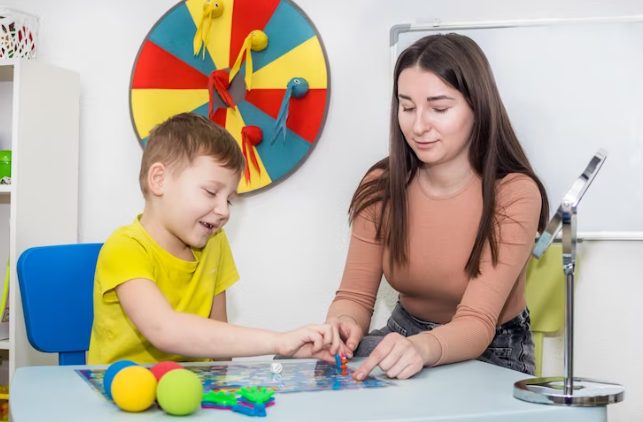
Parenting a child with autism brings unique joys and challenges. However, daily routines—those seemingly simple activities like getting dressed, brushing teeth, or even meal times—can sometimes feel overwhelming. But what if there was a way to transform these moments into opportunities for growth and learning?
Enter Applied Behavior Analysis (ABA), an evidence-based therapy that focuses on encouraging positive behaviors and reducing those that may interfere with a child’s development.
This blog will guide you through integrating ABA techniques into your daily routines, providing actionable strategies to create structure, encourage independence, and nurture meaningful connections at home.
What Is ABA, and Why Does It Matter?
ABA, or Applied Behavior Analysis, is a science-based approach to understanding behavior. It focuses on breaking tasks into manageable steps, using reinforcement to encourage desired actions, and teaching skills that improve daily life. Decades of research show its effectiveness—studies highlight that early ABA interventions can improve communication, social, and adaptive skills in children with autism. (Source)
Here’s the good news: you don’t need to be a certified therapist to use simple ABA strategies. By integrating basic principles into your daily life, you can support your child’s growth while strengthening your bond.
ABA Techniques for Daily Routines
Daily routines provide structure and predictability, which is crucial for children with autism. Here are practical ways to incorporate ABA principles at home:
Morning Routine: Building Independence
The morning rush can be stressful. Here, you can use task analysis to break the routine into small steps. Breaking down tasks into smaller, manageable steps can be incredibly helpful for children with autism as it provides clear, structured guidance.
Children with ASD often struggle with processing complex instructions or managing transitions, so simplifying tasks into individual actions can make them more understandable and achievable.
For example, instead of saying, “Get ready for school,” break it down: (1) Wake up, (2) Brush teeth, (3) Get dressed, (4) Eat breakfast. This step-by-step approach helps create routines, builds independence, and minimizes anxiety, as children know exactly what to expect and what is expected of them.
- Visual Schedules: Create a visual chart with pictures of each step. This provides clarity and reduces anxiety. Visual schedules are incredibly effective tools for children with autism, who often respond better to images than verbal instructions. Use photos, drawings, or printed icons to represent each activity in the morning routine.
- Reinforcement: Celebrate successes, no matter how small. A high-five, verbal praise, or a sticker can go a long way in motivating your child! Tailor rewards to what excites your child. Some children respond well to verbal praise like “Great job brushing your teeth!” Others might prefer tangible rewards, such as earning stickers that gradually lead to a bigger prize.
- Immediate feedback: Offer feedback right after the behavior; if your child successfully gets dressed, celebrate right away with a hug or a high-five. This immediacy helps them link the action to the positive outcome.
Meal Times: Encouraging Communication
Struggles during mealtime? ABA can help turn it into a teaching moment.
- Mand Training: Mand training is a foundational ABA technique that focuses on teaching communication by encouraging your child to request what they want or need. If your child wants juice, for example, you can prompt them by saying, “Juice,” or showing them a picture card of juice. Over time, they’ll learn to associate making a request (whether through words, gestures, or pictures) with receiving the desired item. This method empowers your child to communicate their needs, reducing frustration and fostering independence in everyday interactions.
- Shaping: Shaping is a step-by-step process that helps your child move from simple behaviors to more advanced skills. For instance, if your child begins by pointing to a glass of juice, acknowledge their effort and then gently encourage vocalizing, such as prompting “juh” for juice. Over time, with consistent reinforcement, their communication can evolve into clearer speech or more sophisticated gestures.
- Positive Reinforcement: Positive reinforcement for children with autism is extremely important as it strengthens desired behaviors by rewarding them. If your child demonstrates good mealtime behavior—like sitting calmly or eating without fuss—acknowledge and celebrate it immediately with verbal praise or another preferred reward. For example, say, “I’m so proud of how you’re sitting!” or offer a small treat.
Homework Time: Opportunities for Enhancing Focus
Homework can test patience—for both you and your child. ABA techniques can make it manageable.
- First-Then Strategy: The first-then strategy helps set clear expectations by linking a less preferred task to a more preferred activity. For instance, tell your child, “First finish your homework, then you can play with your toys.” It provides motivation while creating structure and helps your child understand that completing one task leads to a rewarding outcome.
- Token Economy: A token economy is a fun and engaging way to motivate your child! For every completed task, like finishing a worksheet or sitting through a lesson, they earn a token. Once they collect enough tokens, they can exchange them for a reward they love—like extra screen time, a favorite snack, or a small toy. It turns learning into a game and encourages consistent effort.
- Prompting and Fading: Prompting helps your child learn new skills by offering initial assistance, like guiding their hand to write or giving verbal cues. As they become more confident, gradually reduce the prompts, allowing them to complete the task independently. This method builds their confidence and ensures they truly master the skill at their own pace.
Bedtime Routine: Creating Your Child’s Perfect Calm
A consistent bedtime routine promotes better and more improved sleep habits.
- Behavioral Momentum: Start with easy tasks before introducing more challenging ones. Begin your child’s bedtime routine with simple tasks they’re already comfortable with, like putting on pajamas. This creates a sense of accomplishment and builds momentum. Once they’re on a roll, introduce more challenging steps, like brushing their teeth or turning on the night lamp. This strategy reduces resistance and makes the overall routine feel manageable, predictable, and positive.
- Timers: Visual timers make abstract concepts such as time more concrete and visual, and help your child understand how long they have for each step in the routine. For example, setting a timer for five minutes to brush their teeth gives them a clear endpoint, reducing anxiety or frustration. It also keeps activities predictable and helps transitions go more smoothly.
- Reinforce Compliance: When your child completes a step in the bedtime routine, like brushing their teeth without resistance, immediately reward their cooperation. A bedtime story, a hug, or verbal praise like “Great job brushing your teeth!” can act as positive reinforcement. This strengthens their motivation and makes bedtime a rewarding, enjoyable experience.
Why ABA Works | The Science Behind It
Why is ABA such a game-changer for kids with autism? Because it actually works—plain and simple. Think about how life-changing that is! Everyday skills like dressing, communicating, and managing emotions become easier, not just for your child but for the family, as well.
And here’s the best part: ABA isn’t one-size-fits-all. It’s as unique as your little one! Every technique is customized to fit their strengths, challenges, and goals. Whether it’s improving communication or building independence, ABA meets your child where they are and takes them to the next level.
But, what about the results? They speak for themselves! Early intervention with ABA has been shown to improve IQ, communication, and even self-care skills in children with autism. Imagine your child gaining confidence, connecting with others, and thriving in daily life. It’s not just therapy—it’s a proven pathway to growth and development.
In summary, here’s how you can include ABA in your child’s daily routines:
- Visual Schedules & Timers
- Mand Training
- Positive Reinforcement
- First-Then Strategy
- Token Economy
- Prompting and Fading
- Behavioral Momentum
- Reinforce Compliance
Explore what ABA can do for your family –
At Early Autism Ventures (EAV), we understand that every child is unique. Our team of dedicated professionals uses ABA to unlock your child’s full potential. From designing personalized therapy plans to offering parent training, we equip families with the tools they need for success. With our programs, you’ll learn how to apply ABA techniques at home, turning everyday routines into opportunities for growth.
Want more focused support?
Our one-on-one therapy sessions are customized to target your child’s unique needs, whether that’s communication, behavior management, or building independence. And for those critical social skills, our group programs offer a nurturing environment where your child can practice interacting with peers, sharing, and developing friendships. It’s a holistic approach designed to support your entire family every step of the way.
But, let’s face it—implementing new strategies takes time. Progress might feel slow, but consistency is key. By incorporating ABA principles into your home, you’re not just managing daily routines—you’re shaping your child’s ability to navigate the world. Start small. Stay consistent. Celebrate progress. You’ve got this!
Ready to transform your child’s daily routines?
The earlier you start, the better the outcomes. Contact us today to schedule a consultation. Let us help your child thrive—because every moment is a chance for growth.
Schedule a FREE call with our expert clinician now.
Don’t wait! Click here or call us at +91 8929153820 to learn how ABA can make a difference for your family.




































Recent Comments